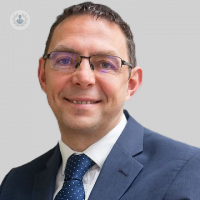Heart health: TAVI vs. AVR – Part 1
Written by:Our hearts are responsible for keeping us alive. However, there are a myriad of problems that can impact our heart health, one of which is aortic stenosis. More common in elderly patients, this condition can be fatal if left untreated. There are two surgical options to treat this problem: TAVI and AVR.
In this two-part series of articles, leading consultant cardiothoracic surgeon, Mr Neil Roberts, explains these procedures and the pros and cons of each. But first, what exactly is aortic stenosis?

What is aortic stenosis, and is it important that it’s treated?
Aortic stenosis is a common problem affecting the aortic valve where the body deposits calcium over time and the valve, which was thin and flexible like tissue paper, starts to become stiff like a coral reef.
When aortic stenosis is severe and causes symptoms, patient mortality is very high (approximately 50% over 1-2 years), so getting the stiff valve treated is very important. The risks of the treatments below range from approximately 1-5% depending on the complexity of the patient, so it is much less risky to have a procedure than to live with aortic stenosis.
What is TAVI?
TAVI stands for transcatheter aortic valve implantation. In simple terms, this means a new valve is transplanted via a catheter which is passed to the heart through the blood vessels, usually inserted at the top of the leg or, less commonly, under the collar bone.
The big difference between a surgical AVR (aortic valve replacement) is that a TAVI pushes the patient’s stiff and calcified valve out of the way during implantation, whereas in a surgical operation, the stiff valve is completely removed and a clear space is created to stitch a new valve into place.
TAVI was originally developed for people not at all fit for surgical operations, and were therefore not having their stiff aortic valves treated. It has been trialled in patients who are at high risk for a surgical operation and found to be similar in those patients (if not sometimes better in the short term), and so it is now being trialled in scientific studies in patients at intermediate risk of a surgical operation (intermediate risk is a complicated medical term, but essentially, it means people over the age of 75-80 and with other medical problems or previous heart operations).
A recent study in the UK, called the UK TAVI trial has now finished recruiting and we are waiting for the results of this to guide us on how best to treat people in the future.
What is AVR?
A surgical aortic valve replacement involves an incision in the front of the chest. The patient’s body is placed on a heart-lung machine, and the heart is stopped, allowing the surgeon to carefully remove the chalky and stiff aortic valve and sew in a new aortic valve. There is a choice of a mechanical heart valve or a tissue heart valve - with TAVI there is currently only a tissue valve. Once the new valve is sewn in position, the heart is restarted and the chest closed.
A surgical aortic valve replacement therefore means a full operation, under full general anaesthetic, and 1-2 days in intensive care followed by 5-7 days in hospital.
New minimal access techniques with smaller incisions are now available for surgical aortic valve replacement, which patients can ask their surgeons about.
Discover the benefits and risks of TAVI and AVR in part 2.
If you require a TAVI or an AVR and you would like to consult your options with an expert, don't hesitate to book an appointment with Mr Neil Roberts via his Top Doctors profile today.


